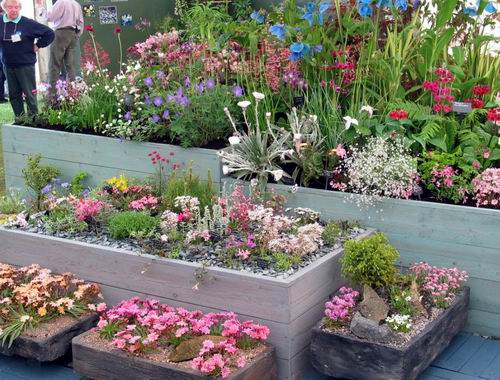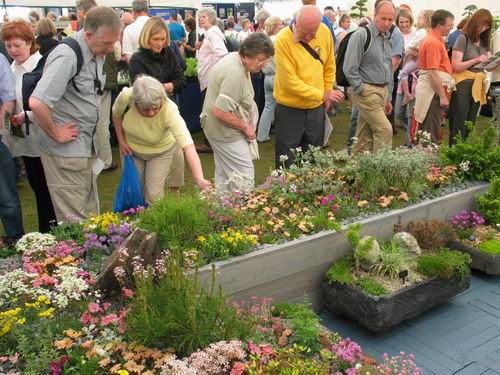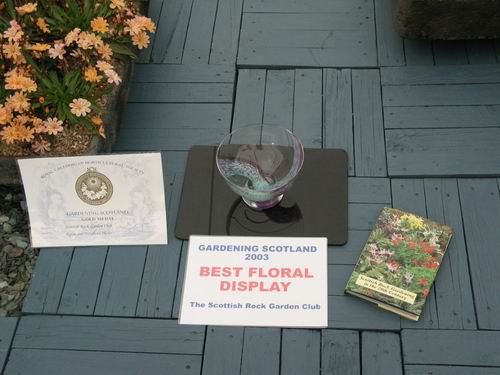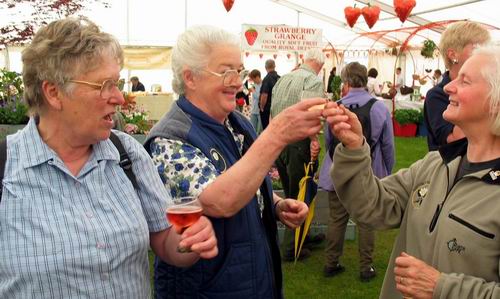 |
Another Gold! |
| Home Recommend This Site To A Friend |
|
GOLD MEDAL NUMBER 7 
On top of that we won the BEST FLORAL EXHIBIT IN THE SHOW for the third time [out of a possible four, as there have been only 4 Gardening Scotland shows so far!]. Remember that the first three shows were the RHS shows at Strathclyde Park. Our record is almost certainly an unrivalled one. 
Our mission this year was to create a display that looked different from previous ones. This is not easy. Year on year many of the plants are the same -- but many are new to the display. We always use rock garden plants and woodland garden plants. 
This year I decided upon a 'New England' pastel theme. Anne prepared and painted all the wooden surfaces with 'Cuprinol' decking stain, using a very pale turquoise green for the woodland areas and grey for the rock garden beds. We used slate chips to top dress the rock garden beds and on parts of the ground covering. When I told members about these colours, many were doubtful of my sanity. However the results speak out for themselves. Again we had Scotland's most beautiful garden. The wooden structures are those which Glassford build for the 2003 show but they were rearranged into an L-shaped raised alpine bed and a square bed of four different levels planted with plants which like woodland conditions. The blue decking which we used a few years ago was painted a lighter blue and was used on the 'patio' area. The pale blue here echoed the 'New England' theme and gave a sensation of water in the garden. 
Overall these raised beds not only brought the plants up closer to eye level but also formed an interesting backdrop for 16 troughs. Visitors could recreate all or part of the display in their own gardens. [The central area could be expanded by any amount needed in any individual garden.] 
The hard structure and the design, while important, are second in importance to the quality of the plants, their relationships, where they are placed and to their condition. Two days of careful grooming were needed to get everything ship shape and Boston fashion. A good eye is the only guide to knowing when a plant is the right place. This year we had lots of colour, especially in the alpine areas. Plant associations in the woodland area are very important. We do not allow any one species to dominate but use species to compliment each other. 
Under the spread of our now resident Acer atropupurpureum, the fabulous Meconopsis x sheldonii flowers topped all others. Their flower colour changes with the season, as does the height at which they start to flower. Spectacular as they are at their home in Susan's garden, where she grows them massed together, in the show it is the individual stems, which are noticed. Each bloom is composed of a palate of different blue shades, from deep dark Oxford blue to paler markings and even deep red / purple markings. 
Hostas, ferns, heucheras and grasses are interplanted with Primulas, Aquilegias, Trollius and many choice individuals. Forming a theme through the planting were pillars of Arisaema elephas and a stunning Arisaema nepenthoides.[ in the centre, just under the Acer palmatum] 
One corner had its own log pile, so that we could use ferns, orchids and wilder plants in one area. A little hegehog and a couple on bunny rabbits keeked out from under Hosta leaves. I feel it is important to have a feature to interest children. 
To appreciate the diversity of plants took much more than a cursory glance, which is what the public gives to some displays. The SRGC's aim is to grab people's attention and to keep our visitors looking at the stand to see just how many different plants there are. Hopefully many of them will join the club but even if they don't we hope to encourage them to grow the plants in their own gardens. [This after all is our constitutional justification for putting on the display.] 
The raised rock walls featured pines, abies, juniper and willows to give height and structure. Between the small trees were open areas filled with treasures. Joining everything together and seeming to flow through the rock garden was a river of Lewisia hybrids [Little Plum and Little Peach]. 
Bright Geraniums and Rhodohypoxis were softened by clouds of saxifrage flowers. Perhaps in a real garden one would take more care to separate different species, in the display, the 'in your face' style works well. All through the planting were little star plants and treasures. Several plants had pink flowers and these were set off especially well by the slate top dressing. 
The troughs stood against the wooden beds and softened them, while the pastel colours formed a beautiful backdrop for the troughs. For the most part, the troughs were the lowest growing areas, only occasionally did trough plants reach up to the surface of the raised beds. 
15 0r 16 troughs featuring many types of rock plant and different themes were used. I try to give each trough its own identity; either a collection of plants, which need similar conditions, a group of related plants or plants which just look good together. Sometimes the plan is dictated by the plants, while at other times a piece of driftwood or bits of rock capture the imagination and I look for plants to accompany them. 
The public found Leptospermums interesting and asked many questions about them. The dwarf Hostas were a talking point and many people wondered if the Pines were SRGC bonsais! 
Two troughs have been planted for seven years and as well as being ornamental; they let people know how durable are our 'fish box troughs'. We even had two 'mono species' Lewisia troughs: - one with Lewisia 'Little Plum' and the other with L. 'Little Peach'. Troughs often need a bit of height and I feel that "Plants in troughs need rocks!" so I felt I was being quite adventurous planting a trough with no rocks or trees. 
All plants need to be named and David spent many hours writing out new labels [silver pen on black, as per RHS rules is best]. The plants in the troughs are identified using laminated photographs of each trough. 
There were dozens if not hundreds of flower associations to marvel at in the display. Care in planting, plant associations, attention to the details of removing dead flowers, bruised foliage etc and tidy top dressing are the keys to success. 


Well done TEAM SRGC! ^ back to the top ^ |